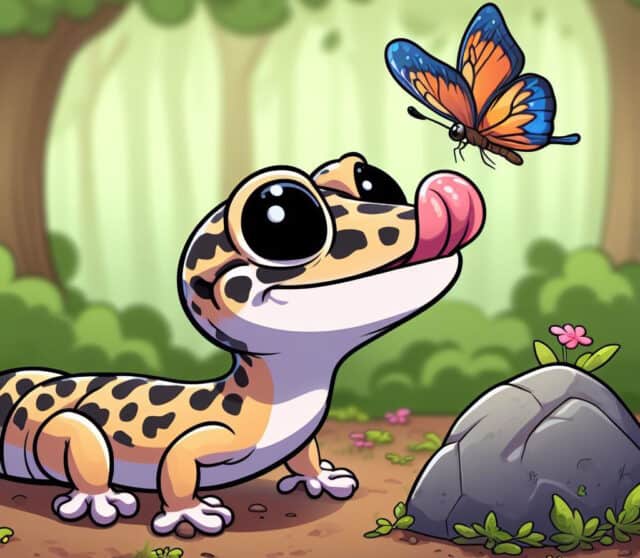Yes, leopard geckos can eat butterflies, but it’s essential to tread with caution. While the vibrant flutter of a butterfly might seem like a tempting snack for these reptiles, it isn’t always the best dietary choice.
Butterfly Suitability: Not all butterflies are safe for leopard geckos. Only a few types, especially those commonly found in North America, are toxin-free and pose no health risks.
Nutrition Concerns: Butterflies may not provide the right balance of nutrients for leopard geckos. Regular gecko foods like crickets, mealworms, and dubia roaches offer a more comprehensive nutrient profile, especially in calcium and vitamins.
Risks of Wild-Caught Butterflies: Using wild-caught butterflies as a food source can expose leopard geckos to potential parasites and diseases.
Better Alternatives Available: Instead of butterflies, provide a balanced diet using mealworms, crickets, superworms, and dubia roaches from trusted sources. Always ensure fresh water, proper heat (around 88-92°F in the warm end), and the addition of supplements like calcium powder.
Legal and Ethical Concerns: There are legal regulations against the collection and use of certain butterfly species, especially if they’re endangered. Ethically, consider the humane treatment of insects used as prey.
Can Leopard Geckos Eat Butterflies?
At first glance, the idea of a leopard gecko munching on a delicate butterfly might raise eyebrows. Can they really eat them? And more importantly, should they?
Types of Butterflies That Could Be Safe
Butterflies, with their vivid colors and delicate wings, are more than just a feast for our eyes. Some of them can also be considered as a treat for leopard geckos. In North America, a variety of butterflies thrive, but not all are suitable for consumption. For a butterfly to be deemed safe for a leopard gecko, it should pose no health risks and be toxin-free. Here are a few common species that might fit the bill:
Cabbage White (Pieris rapae): A staple in many North American gardens, the Cabbage White is a small white butterfly that’s generally considered harmless.
Clouded Sulphur (Colias philodice): Another white butterfly, this species is prevalent in many regions and is toxin-free.
Common Buckeye (Junonia coenia): Recognizable by their brown wings with multiple eye patterns, these butterflies don’t usually carry toxins harmful to leopard geckos.
Painted Lady (Vanessa cardui): With their stunning orange, black, and white patterned wings, Painted Ladies are not just beautiful but also safe for consumption.
Nutritional Value of Butterflies
When it comes to feeding leopard geckos, understanding the nutritional value of their food is crucial. Butterflies, as potential snacks, have their own unique composition. But how do they stack up against the common insects fed to these reptiles?
- Moisture: Butterflies have a relatively high moisture content compared to other insects. While this might be beneficial in small amounts, it’s essential not to overdo it, as too much moisture can be detrimental to a gecko’s health.
- Protein: In the realm of protein, butterflies come in a bit lower than some of the powerhouse insects like crickets and dubia roaches. Protein is vital for growth and muscle development, so while butterflies can provide some, they shouldn’t be the primary protein source.
- Fat: When it comes to fat, butterflies are on the leaner side, especially when compared to mealworms, which are known for their higher fat content. This makes butterflies a potentially good treat but not a substantial energy source.
- Fiber: Butterflies, being soft-bodied insects, don’t provide as much fiber as some other insects. For instance, crickets and black soldier fly larvae, with their exoskeletons, offer more roughage.
- Calcium to Phosphorus Ratio: This is a crucial factor in reptile nutrition. Butterflies tend to have a lower calcium to phosphorus ratio than desirable for leopard geckos. In contrast, black soldier fly larvae excel in this aspect, making them a preferable option for ensuring bone health.
| Insect | Moisture | Protein | Fat | Fiber | Calcium:Phosphorus Ratio |
|---|---|---|---|---|---|
| Butterflies | High | Medium | Low | Low | Lower |
| Crickets | Medium | High | Medium | Medium | Balanced |
| Mealworms | Medium | Medium | High | Medium | Imbalanced |
| Dubia Roaches | Medium | High | Medium | Medium | Balanced |
| Black Soldier Fly Larvae | Medium | High | Medium | High | Superior |
Potential Health Risks for Leopard Geckos Eating Butterflies
While the idea of feeding butterflies to leopard geckos might seem intriguing, it’s not without its potential pitfalls. Just as there are butterflies that can be safe, there are also inherent risks associated with their consumption. These concerns range from potential toxins present in the butterflies to an imbalanced nutrient profile.
Could Contain Toxins
Butterflies, despite their captivating beauty, come with a hidden danger: the potential presence of toxins. In nature, many butterfly species have evolved to accumulate toxins as a defense mechanism against predators. These toxins, originating from their environment, can be harmful when ingested by leopard geckos.
One of the primary ways butterflies amass toxins is through their diet. As caterpillars, they munch on a variety of plants. Some of these plants, particularly those laced with insecticides or inherently poisonous, contain harmful compounds. As the caterpillar transitions into a butterfly, these toxins become concentrated in their body. When a leopard gecko eats such a butterfly, these toxins are transferred, posing a risk of poisoning.
Moreover, butterflies exposed to environments with heavy insecticide use can absorb these chemicals, further elevating the risk. Additionally, while not a toxin per se, ticks and other external parasites might latch onto butterflies, potentially introducing further health risks to the gecko.
May Not Provide The Right Mix of Nutrients
Nutrition plays a pivotal role in ensuring the health and longevity of leopard geckos. While butterflies can serve as a protein source, they might not offer the right mix of nutrients that geckos require. Think of it like eating a diet consisting solely of salads; while salads are nutritious, they alone won’t provide all the essential nutrients needed for optimal health.
Butterflies, in their naturally occurring form, have a nutritional composition that’s distinct from what leopard geckos are biologically attuned to consume. For instance, though they offer protein, they may fall short in providing essential elements like calcium and certain vitamins. A deficiency in calcium can lead to issues like Metabolic Bone Disease, a common ailment in reptiles that affects bone health. Similarly, lacking in particular vitamins can hamper overall health, immune function, and vitality of the gecko.
Parasites from Wild-Caught Butterflies
Wild-caught butterflies bring with them an added layer of concern when considered as a potential food source: the risk of parasites and diseases. Nature, in all its splendor, is also a hub for various microorganisms, some of which can pose health risks to leopard geckos.
Wild environments are rife with parasites that butterflies can inadvertently pick up. When these insects are consumed by leopard geckos, there’s a possibility of transmitting these parasites. Such infestations can lead to gastrointestinal issues, lethargy, and other health complications in geckos. Moreover, certain diseases prevalent in the wild can also find their way into a gecko’s system through the ingestion of infected butterflies, further jeopardizing their health.
Given these risks, the source and quality of butterflies become of paramount importance. Relying on wild-caught specimens might seem like a natural and organic choice, but the inherent uncertainties regarding their health status make them a dicey option. For those considering butterflies as a treat or occasional food source, it’s crucial to ensure they are sourced from reputable suppliers that can guarantee their safety and quality.
Alternatives to Butterfly Feeding for Leopard Geckos
While butterflies might catch the fancy of some leopard geckos and their keepers, they aren’t the optimal food choice due to potential health risks. Thankfully, there are alternative food options that not only satiate a gecko’s appetite but also fulfill its nutritional requirements.
Mealworms, crickets, superworms, and dubia roaches reign supreme when it comes to providing leopard geckos with the necessary nutrients they need to thrive. Each of these insects offers a unique nutritional profile, ensuring that geckos get a well-rounded diet. For instance, crickets are an excellent source of protein, while dubia roaches offer a good balance of protein and fat. Mealworms and superworms, on the other hand, are calorie-dense, making them ideal for geckos needing a little weight boost.
However, where these insects come from matters a great deal. It’s essential to source them from a trusted supplier who ensures their cleanliness and safety. Such a precautionary step eliminates the potential transmission of diseases or ingestion of harmful substances.
In addition to offering these insect alternatives, it’s vital to ensure leopard geckos have access to fresh water at all times. Hydration plays a significant role in their overall health and digestive processes. Alongside this, proper heat sources are crucial. Leopard geckos require specific temperature gradients to digest their food effectively and stay active.
Ethical and Legal Considerations
When considering the diet for leopard geckos, it’s not just about nutrition and health. Ethical and legal considerations play a pivotal role in deciding what’s on the menu, especially when it comes to butterflies.
From an ethical standpoint, there’s a debate surrounding the use of live insects as prey. While it’s natural for geckos to hunt and consume live prey in the wild, in captivity, the act can raise concerns about the humane treatment of both predator and prey. It’s essential to ensure that the insects used as food are raised in decent conditions and that the hunting process doesn’t cause undue stress to either party.
Legal regulations further complicate the matter. In many regions, there are rules surrounding the collection and use of certain butterfly species. Some butterflies are endangered or protected, making it illegal to capture or use them as food. These laws exist to conserve dwindling butterfly populations and maintain a balance in local ecosystems.
Key factors to consider include:
Endangered Species: Ensure that the butterfly species you’re considering is not on any endangered or protected lists. Using such species could not only harm the environment but also land you in legal trouble.
Humane Treatment: Regardless of the insect in question, ensure it’s raised and used humanely. Avoid unnecessary suffering for both the predator and the prey.
Local Regulations: Always be aware of local regulations regarding the collection and use of insects, especially butterflies. These laws can vary widely from one region to another.
Natural Diet: While it’s tempting to provide a varied diet, it’s crucial to consider what’s best and natural for the leopard gecko, balancing their health with ethical treatment of prey.

